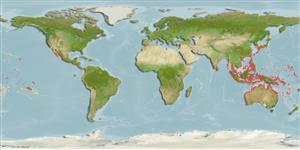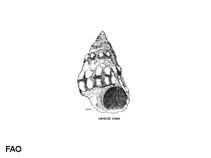Nodilittorina pyramidalis (Quoy & Gaimard, 1833)
Pyramidal prickly-winkle| Native range | All suitable habitat | Point map | Year 2050 |

|
| This map was computer-generated and has not yet been reviewed. |
| Nodilittorina pyramidalis AquaMaps Data sources: GBIF OBIS |
Classification / Names Common names | Synonyms | CoL | ITIS | WoRMS
Gastropoda | Littorinimorpha | Littorinidae
Environment: milieu / climate zone / depth range / distribution range Ecology
Benthic; depth range 0 - 6 m (Ref. 100892). Tropical
Distribution Countries | FAO areas | Ecosystems | Occurrences | Introductions
Indo-Pacific: from the west coast of India to eastern Polynesia; north to Japan and south to southern New South Wales and Norfolk Island; also occurring in Pitcairn and Easter Islands (subspecies pascua).
Length at first maturity / Size / Weight / Age
Maturity: Lm ? range ? - ? cm Max length : 2.5 cm SHL male/unsexed; (Ref. 349); common length : 2.0 cm SHL male/unsexed; (Ref. 349)
Found in upper intertidal zone and splash area of the supralittoral zone (Ref. 349). Also on rocks near high tide mark (Ref. 799). Common within pits and crevices of complex rock patches (Refs. 100891, 125338).
Life cycle and mating behavior Maturity | Reproduction | Spawning | Eggs | Fecundity | Larvae
Members of the order Neotaenioglossa are mostly gonochoric and broadcast spawners. Life cycle: Embryos develop into planktonic trocophore larvae and later into juvenile veligers before becoming fully grown adults.
Main reference
References | Coordinator | Collaborators
Poutiers, J.M. 1998. (Ref. 349)
IUCN Red List Status (Ref. 130435)
CITES status (Ref. 108899)
Not Evaluated
CMS (Ref. 116361)
Not Evaluated
Threat to humans
Human uses
Fisheries: commercial
| FishSource |
Tools
More information
Age/Size
Growth
Length-weight
Length-length
Morphology
Larvae
Abundance
Growth
Length-weight
Length-length
Morphology
Larvae
Abundance
Internet sources
BHL | BOLD Systems | CISTI | DiscoverLife | FAO(Publication : search) | Fishipedia | GenBank (genome, nucleotide) | GloBI | Gomexsi | Google Books | Google Scholar | Google | PubMed | Tree of Life | Wikipedia (Go, Search) | Zoological Record
Estimates based on models
Preferred temperature
(Ref. 115969): 21.4 - 29.3, mean 28.4 (based on 3263 cells).
Price category
(Ref. 80766):
Unknown.



